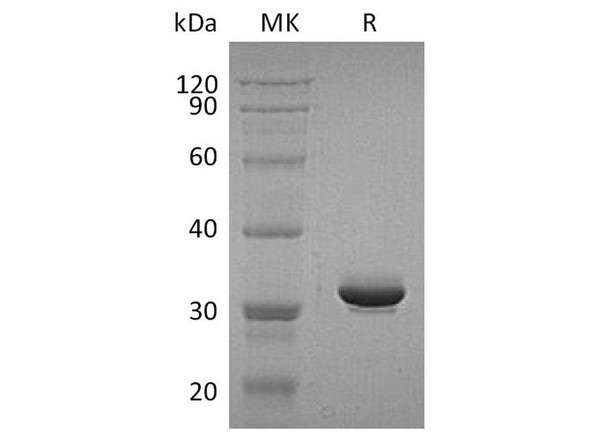Enzymes Recombinant Proteins
Human TEK Fc Recombinant Protein (RPPB2660)
- SKU:
- RPPB2660
- Product Type:
- Recombinant Protein
- Species:
- Human
- Uniprot:
- Q02763
- Research Area:
- Enzymes
Description
| Product Name: | Human TEK Fc Recombinant Protein |
| Product Code: | RPPB2660 |
| Size: | 10µg |
| Species: | Human |
| Target: | TEK Fc |
| Synonyms: | Angiopoietin-1 receptor precursor, Tyrosine-protein kinase receptor TIE-2, hTIE2, Tyrosine-protein kinase receptor TEK, p140 TEK, Tunica interna endothelial cell kinase, CD202b, VMCM, VMCM1, TIE2. |
| Source: | Insect Cells |
| Physical Appearance: | Sterile Filtered White lyophilized (freeze-dried) powder. |
| Formulation: | TEK Fc Chimera was lyophilized from a concentrated (1mg/ml) sterile solution containing 1xPBS. |
| Solubility: | It is recommended to reconstitute the lyophilized TIE-2 Fc Chimera in sterile water not less than 100�g/ml, which can then be further diluted to other aqueous solutions. |
| Stability: | Lyophilized sTIE-2 although stable at room temperature for 3 weeks, should be stored desiccated below -18°C. Upon reconstitution TEK should be stored at 4°C between 2-7 days and for future use below -18°C.For long term storage it is recommended to add a carrier protein (0.1% HSA or BSA).Please prevent freeze-thaw cycles. |
| Purity: | Greater than 90.0% as determined by:(a) Analysis by RP-HPLC.(b) Analysis by SDS-PAGE. |
TIE-1 (tyrosine kinase with Ig and EGF homology domains 1) and TIE-2/Tek comprise a receptor tyrosine kinase (RTK) subfamily with unique structural characteristics: two immunoglobulin-like domains flanking three epidermal growth factor (EGF)-like domains and followed by three fibronectin type III-like repeats in the extracellular region and a split tyrosine kinase domain in the cytoplasmic region. These receptors are expressed primarily on endothelial and hematopoietic progenitor cells and play critical roles in angiogenesis, vasculogenesis and hematopoiesis. Human TIE-1 cDNA encodes a 1122 amino acid (aa) residue precursor protein with an 18 residue putative signal peptide, a 726 residue extracellular domain and a 353 residue cytoplasmic domain. Two ligands, angiopoietin-1 (Ang1) and angiopoietin-2 (Ang2), which bind TIE-2 with high-affinity have been identified. Ang2 has been reported to act as an antagonist for Ang1. Mice engineered to overexpress Ang2 or to lack Ang1 or Tie-1 display similar angiogenic defects.
Soluble TEK Human Recombinant fused with the Fc part of human IgG1 produced in baculovirus is a monomeric, glycosylated, polypeptide containing 730 amino acids and having a total molecular mass of 250 kDa. Human TIE-2/Fc monomer has a calculated molecular mass of approximately 125 kDa. As a result of glycosylation, the recombinant protein migrates as an approximately 140 kDa protein in SDS-PAGE under reducing conditions.The TEK Fc Chimera is purified by proprietary chromatographic techniques.
| UniProt Protein Function: | TIE2: a receptor tyrosine kinase of the Tie family. Receptor for angiopoietin 1. Expressed almost exclusively in endothelial cells. May constitute the earliest mammalian endothelial cell lineage marker. Appears to be critical for endothelial cell-smooth muscle cell communication in venous morphogenesis. TEK is closely related to the TIE receptor tyrosine kinase. |
| UniProt Protein Details: | Protein type:Protein kinase, TK; Protein kinase, tyrosine (receptor); EC 2.7.10.1; Kinase, protein; Membrane protein, integral; TK group; Tie family Chromosomal Location of Human Ortholog: 9p21 Cellular Component: microvillus; focal adhesion; cell surface; basolateral plasma membrane; integral to plasma membrane; extracellular region; actin filament; intercellular junction; lipid raft; perinuclear region of cytoplasm; apical plasma membrane; stress fiber; basal plasma membrane; plasma membrane Molecular Function:protein binding; growth factor binding; protein-tyrosine kinase activity; receptor activity; transmembrane receptor protein tyrosine kinase activity; ATP binding; protein kinase activity Biological Process: response to peptide hormone stimulus; peptidyl-tyrosine phosphorylation; response to cAMP; heart development; protein amino acid autophosphorylation; cell-matrix adhesion; positive regulation of cytokine secretion during immune response; signal transduction; cell-cell adhesion; cell-cell signaling; positive regulation of focal adhesion formation; angiogenesis; endochondral ossification; organ regeneration; Tie receptor signaling pathway; regulation of establishment and/or maintenance of cell polarity; positive regulation of phosphoinositide 3-kinase activity; positive regulation of peptidyl-serine phosphorylation; protein oligomerization; positive regulation of phosphoinositide 3-kinase cascade; positive regulation of protein kinase B signaling cascade; negative regulation of angiogenesis; positive regulation of angiogenesis; positive regulation of protein import into nucleus; response to estrogen stimulus; negative regulation of inflammatory response; endothelial cell proliferation; response to hypoxia; positive regulation of endothelial cell proliferation; regulation of vascular permeability; sprouting angiogenesis; positive regulation of protein amino acid phosphorylation; blood coagulation; leukocyte migration; transmembrane receptor protein tyrosine kinase signaling pathway; negative regulation of apoptosis Disease: Venous Malformations, Multiple Cutaneous And Mucosal |
| NCBI Summary: | The TEK receptor tyrosine kinase is expressed almost exclusively in endothelial cells in mice, rats, and humans. This receptor possesses a unique extracellular domain containing 2 immunoglobulin-like loops separated by 3 epidermal growth factor-like repeats that are connected to 3 fibronectin type III-like repeats. The ligand for the receptor is angiopoietin-1. Defects in TEK are associated with inherited venous malformations; the TEK signaling pathway appears to be critical for endothelial cell-smooth muscle cell communication in venous morphogenesis. TEK is closely related to the TIE receptor tyrosine kinase. [provided by RefSeq, Jul 2008] |
| UniProt Code: | Q02763 |
| NCBI GenInfo Identifier: | 218511853 |
| NCBI Gene ID: | 7010 |
| NCBI Accession: | Q02763.2 |
| UniProt Secondary Accession: | Q02763,Q5TCU2, Q8IV34, A8K6W0, B4DH20, B4DHD3, D3DRK5 E7EWI2, |
| UniProt Related Accession: | Q02763 |
| Molecular Weight: | 60.2kD |
| NCBI Full Name: | Angiopoietin-1 receptor |
| NCBI Synonym Full Names: | TEK tyrosine kinase, endothelial |
| NCBI Official Symbol: | TEK�� |
| NCBI Official Synonym Symbols: | TIE2; VMCM; TIE-2; VMCM1; CD202B�� |
| NCBI Protein Information: | angiopoietin-1 receptor; hTIE2; p140 TEK; soluble TIE2 variant 1; soluble TIE2 variant 2; endothelial tyrosine kinase; tyrosine-protein kinase receptor TEK; tunica interna endothelial cell kinase; tyrosine-protein kinase receptor TIE-2; tyrosine kinase with Ig and EGF homology domains-2 |
| UniProt Protein Name: | Angiopoietin-1 receptor |
| UniProt Synonym Protein Names: | Endothelial tyrosine kinase; Tunica interna endothelial cell kinase; Tyrosine kinase with Ig and EGF homology domains-2; Tyrosine-protein kinase receptor TEK; Tyrosine-protein kinase receptor TIE-2; hTIE2; p140 TEK |
| Protein Family: | Angiopoietin-1 receptor |
| UniProt Gene Name: | TEK�� |
| UniProt Entry Name: | TIE2_HUMAN |






